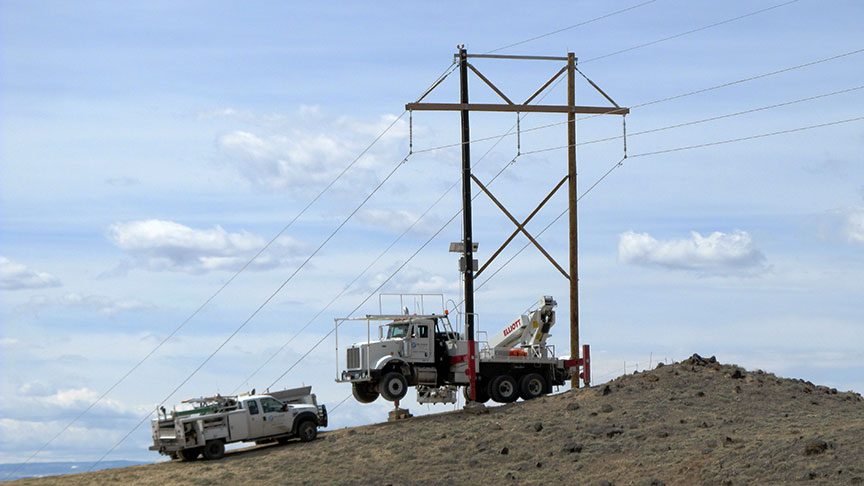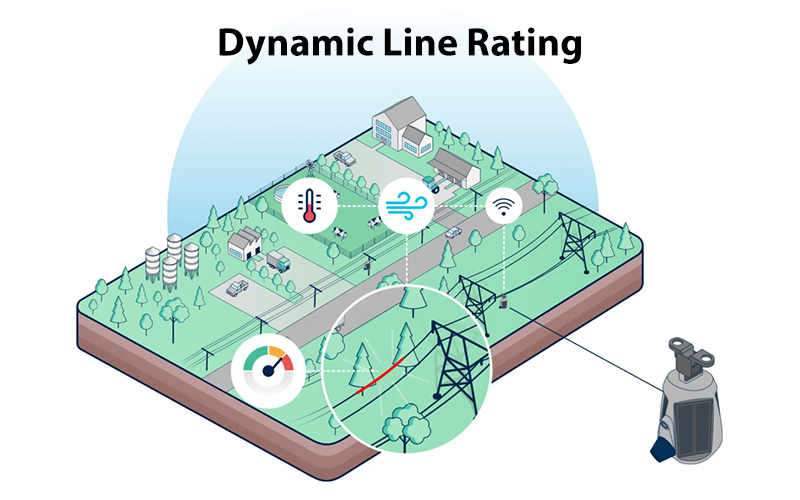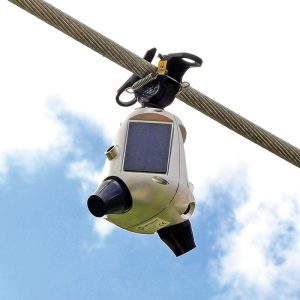
The U.S. transmission system must be upgraded and expanded to carry more clean energy over longer distances. One promising option to help achieve this is dynamic line ratings (DLRs).
What Are Dynamic Line Ratings?
Transmission lines have “line ratings” representing the maximum amount of power that can safely flow through them. These ratings are necessary because transmission lines heat up, stretch, and sag as power flows through them. If lines sag too much, they risk touching trees or vegetation, potentially causing fires.
Traditional line ratings are static and based on conservative assumptions about weather conditions. However, actual weather conditions can significantly impact how much power a line can safely carry. For example:
- On hot summer days, lines will heat up and sag faster
- On cool, windy days, lines can carry more power safely
Dynamic line ratings allow these ratings to be adjusted in real-time based on actual weather conditions. As Paul Denholm, a senior research fellow at the National Renewable Energy Laboratory (NREL) explains:
“We can easily add tools that monitor local weather conditions along various parts of a transmission line and say, ‘You know what? It’s cooler. Let’s increase the rating of this line by 5% or 10%.'”
How DLRs Work
DLRs use sensors and monitoring equipment to measure real-time conditions like:
- Ambient temperature
- Wind speed and direction
- Solar radiation
- Line sag
This data is fed into algorithms that can dynamically adjust line ratings hourly or even more frequently. When conditions allow, operators can safely increase power flow through lines. During unfavorable conditions, ratings can be lowered to maintain safety margins.
Benefits of Dynamic Line Ratings
Implementing DLRs on existing transmission infrastructure offers several key benefits:
Increased Transmission Capacity
By allowing higher power flows when conditions permit, DLRs can increase the overall transmission capacity of the grid without building new lines. This allows greater utilization of existing assets.
Cost Savings
Maximizing the use of existing lines helps utilities avoid or defer expensive investments in new transmission. These cost savings can ultimately benefit consumers.
Improved Renewable Integration
DLRs allow the grid to carry more low-cost renewable energy when it’s available. As Denholm notes:
“If we can use dynamic line ratings to relieve a little bit of the congestion that builds up on our power grid, that would allow us to use more of the abundant, low-cost energy generated by renewable resources.”
Enhanced Grid Reliability
DLRs give operators more flexibility to respond to changing grid conditions. This can help prevent outages, especially during extreme weather events. For example, during very cold winter nights when demand is high, DLRs could allow increased power flow to meet demand.
Low-Risk Implementation
Adding DLR capability to existing lines is relatively low-risk. If sensors or software fail, lines can simply revert to traditional static ratings until fixed.
Current Status and Future Potential
While some utilities have begun implementing DLRs, they are currently used on only a small fraction of transmission lines. There is significant potential to expand their use to help meet clean energy goals and enhance grid flexibility.
As the grid incorporates more variable renewable energy, the ability to dynamically optimize transmission capacity will become increasingly valuable. DLRs represent a cost-effective way to squeeze more capacity out of existing infrastructure as the power system evolves.
In summary, dynamic line ratings offer a promising tool to enhance transmission capacity, integrate renewables, improve reliability and defer costly upgrades – all by making better use of existing assets. As the grid modernizes, DLRs are likely to play an expanding role in optimizing transmission operations.
Key Differences Between DLRs and AARs

While dynamic line ratings (DLRs) and ambient-adjusted ratings (AARs) both aim to improve the accuracy of transmission line capacity estimates, there are several key differences between these approaches:
- Inputs considered:
- AARs primarily reflect up-to-date forecasts of ambient air temperature and account for daytime/nighttime solar heating.
- DLRs consider a broader set of inputs, including ambient air temperature, wind speed and direction, solar heating intensity, transmission line tension, transmission line sag, and potentially other factors.\
- Level of dynamism:
- AARs are updated at least hourly to reflect ambient temperature forecasts.
- DLRs can potentially be updated more frequently (sub-hourly) as they consider more real-time inputs.
- Complexity:
- AARs are relatively simpler to implement, mainly requiring temperature forecasts.
- DLRs are more complex, often requiring additional sensors and monitoring equipment on transmission lines.
- Regulatory requirements:
- Order No. 881 mandated the implementation of AARs by transmission providers.
- DLRs were not mandated, but the order removed some barriers to their voluntary implementation.
- Definition:
- AAR is more narrowly defined in the regulations.
- DLR is defined more broadly to potentially include AAR as well as additional dynamic factors.
In essence, both AARs and DLRs meet FERC Order 881 compliance. AARs can be seen as a subset or simpler version of DLRs, focusing primarily on temperature adjustments, while DLRs provide a more comprehensive, dynamic approach to line rating that considers multiple environmental and physical factors. The implementation of AARs serves as a foundation for potentially more advanced DLR systems in the future, as utilities and grid operators gain experience with more dynamic rating approaches.
Why Consider Dynamic Line Ratings with Sentrisense

While implementing dynamic line ratings (DLRs) can provide significant benefits, it also comes with challenges around installation, data management, and integration. Sentrisense offers an innovative solution that addresses many of these challenges:
Key Advantages of Sentrisense for DLR
- Low-Cost, Easy Installation: Sentrisense’s Sentri device can be installed on active power lines in less than a minute without requiring outages. This dramatically reduces implementation costs and disruption. It also benefits long-term sustainable energy management goals by conserving energy
- Universal Adaptability: The sensors are designed to work with any grid infrastructure, from small to large scale. Remote updates allow capabilities to expand over time.
- Powerful Data Analytics: Sentrisense provides real-time, on-site data directly from power lines. Users can leverage pre-built analytics models or use the raw data with their own tools.
- Comprehensive Monitoring: In addition to DLR, Sentrisense offers Quick Incident Detection and Early Fault Detection, providing an integrated approach to grid management.
- Long-Term Reliability: With over 10 years of autonomy and solar recharging, the sensors require minimal maintenance while providing long-term power line monitoring capabilities.
By addressing key implementation challenges, Sentrisense’s solution could help accelerate the adoption of DLR technology across the power grid. The combination of easy installation, powerful analytics, and integrated monitoring features provides a compelling option for utilities looking to optimize their transmission capacity through DLR.
